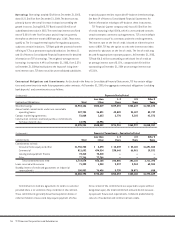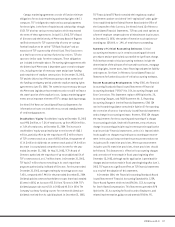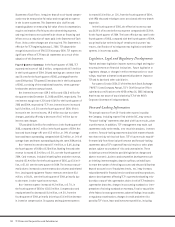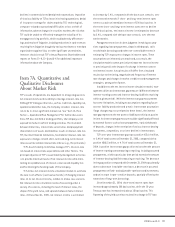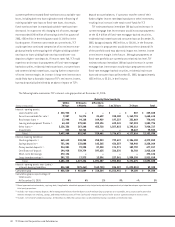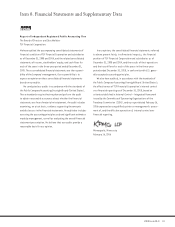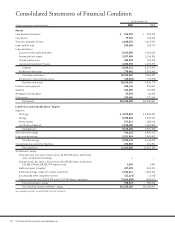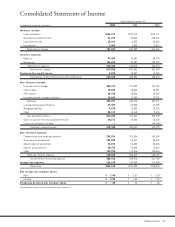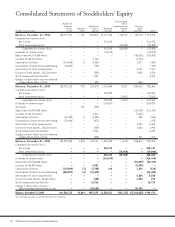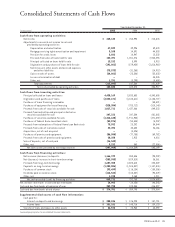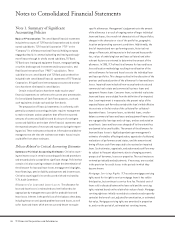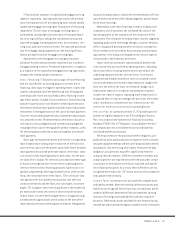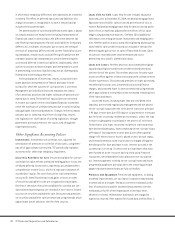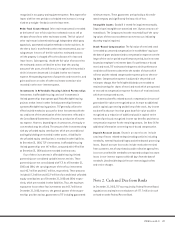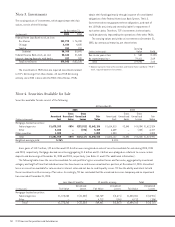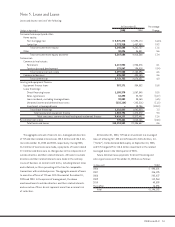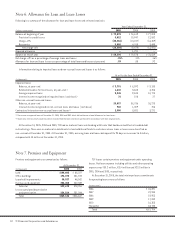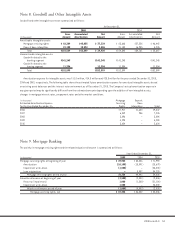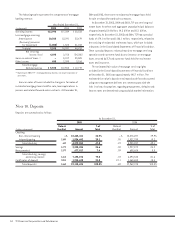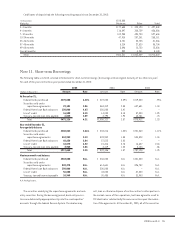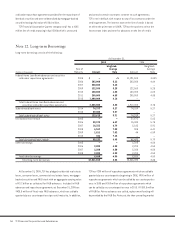TCF Bank 2005 Annual Report Download - page 66
Download and view the complete annual report
Please find page 66 of the 2005 TCF Bank annual report below. You can navigate through the pages in the report by either clicking on the pages listed below, or by using the keyword search tool below to find specific information within the annual report.
46 TCF Financial Corporation and Subsidiaries
Note 1. Summary of Significant
Accounting Policies
Basis of Presentation The consolidated financial statements
include the accounts of TCF Financial Corporation and its wholly
owned subsidiaries. TCF Financial Corporation (“TCF” or the
“Company”) is a Delaware national financial holding company
engaged primarily in community banking and leasing and equip-
ment finance through its wholly owned subsidiary, TCF Bank.
TCF Bank owns leasing and equipment finance, mortgage banking,
securities brokerage and investment and insurance sales, and
Real Estate Investment Trust (“REIT”) subsidiaries. These
subsidiaries are consolidated with TCF Bank and are therefore
included in the consolidated financial statements of TCF Financial
Corporation. All significant intercompany accounts and transac-
tions have been eliminated in consolidation.
Certain reclassifications have been made to prior years’
financial statements to conform to the current year presentation.
For Consolidated Statements of Cash Flows purposes, cash and
cash equivalents include cash and due from banks.
The preparation of financial statements in conformity with
generally accepted accounting principles requires management
to make estimates and assumptions that affect the reported
amounts of assets and liabilities and disclosure of contingent
assets and liabilities at the date of the financial statements and
the reported amounts of revenues and expenses during the report-
ing period. These estimates are based on information available to
management at the time the estimates are made. Actual results
could differ from those estimates.
Policies Related to Critical Accounting Estimates
Summary of Critical Accounting Estimates Critical account-
ing estimates occur in certain accounting policies and procedures
and are particularly susceptible to significant change. Policies that
contain critical accounting estimates include the determination of
the allowance for loan and lease losses, mortgage servicing rights,
lease financings, pension liability and expenses and income taxes.
Critical accounting policies are discussed with and reviewed by
TCF’s Audit Committee.
Allowance for Loan and Lease Losses The allowance for
loan and lease losses is maintained at a level believed to be
appropriate by management to provide for probable loan and
lease losses inherent in the portfolio as of the balance sheet date,
including known or anticipated problem loans and leases, as well
as for loans and leases which are not currently known to require
specific allowances. Management’s judgement as to the amount
of the allowance is a result of ongoing review of larger individual
loans and leases, the overall risk characteristics of the portfolios,
changes in the character or size of the portfolios, geographic
location and prevailing economic conditions. Additionally, the
level of impaired and non-performing assets, historical net
charge-off amounts, delinquencies in the loan and lease portfo-
lios, values of underlying loan and lease collateral and other
relevant factors are reviewed to determine the amount of the
allowance. In 2005, TCF refined its allowance for loan and lease
losses allocation methodology resulting in an allocation of the
entire allowance for loan and lease losses to the individual loan
and lease portfolios. This change resulted in the allocation of the
previous unallocated portion of the allowance for loan and lease
losses. Impaired loans include all non-accrual and restructured
commercial real estate and commercial business loans and
equipment finance loans. Consumer loans, residential real estate
loans and leases are excluded from the definition of an impaired
loan. Loan impairment is measured as the present value of the
expected future cash flows discounted at the loan’s initial effective
interest rate or the fair value of the collateral for collateral-
dependent loans. Consumer loans, residential loans, smaller-
balance commercial loans and leases and equipment finance loans
are segregated by loan type and sub-type, and are evaluated on
a pool basis. Loans and leases are charged off to the extent they
are deemed to be uncollectible. The amount of the allowance for
loan and lease losses is highly dependent upon management’s
estimates of variables affecting valuation, appraisals of collateral,
evaluations of performance and status, and the amounts and
timing of future cash flows expected to be received on impaired
loans. Such estimates, appraisals, evaluations and cash flows may
be subject to frequent adjustments due to changing economic
prospects of borrowers, lessees or properties. These estimates are
reviewed periodically and adjustments, if necessary, are recorded
in the provision for credit losses in the periods in which they
become known.
Mortgage Servicing Rights TCF records a mortgage servicing
rights asset for its right to service mortgage loans it has sold to
third parties, but continues to service for a fee. The total cost of
loans sold is allocated between the loans sold and the servicing
rights retained based on the relative fair values of each. Mortgage
servicing rights are initially recorded at cost and are subsequently
carried at the lower of cost, adjusted for amortization, or estimated
fair value. Mortgage servicing rights are amortized in proportion
to, and over the period of, estimated net servicing income.
Notes to Consolidated Financial Statements


